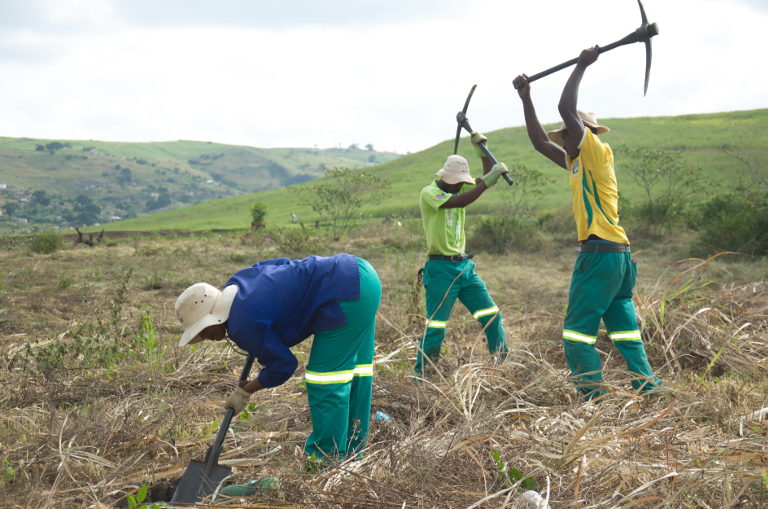Conservation, along with ecological restoration and stewardship-oriented and “convivial conservation”—in the sense of Bram Büscher and Rob Fletcher’s opening essay—must be approached together, at landscape and at ecoregional scales.1 More broadly, conservation, restoration, and ecosystem management should be conceptualized, sited, and implemented on the basis of stewardship and the clear notion of a “continuum” of restorative activities.2 This can best be done by addressing ecosystem health and human population health together, since the two are inexorably linked in today’s crowded and human-dominated world.3
Conservation in isolation has failed to protect the majority of the Earth’s land area. A heart-wrenching 75% of it is degraded according to a 2018 report by the Intergovernmental Science-Policy Platform on Biodiversity and Ecosystem Services.4 While it is valuable to continue drawing a distinction between the different activities of conservation (trying to protect and actively maintain endangered species and ecosystems) and restoration (repairing ecosystems, or helping the healing process for recovery of ecosystem health), conservation needs to be part of a larger matrix that includes the restoration of degraded and fragmented ecosystems and the transition towards ecosystem management approached with an “inside-out” perspective.5 As the originators of this phrase, David Waltner-Toews et al. put it: “Environmental management has traditionally considered humans as external to ‘pristine’ ecosystems, but growing awareness of the complexity of ecosocial systems shows this approach to be unrealistic. When management decisions are made, people must be considered as integral to ecological systems.”
Restoration represents the most viable and effective mechanism to conserve ecosystems—for example, to restore buffers around remnant habitats, reconnect isolated patches, improve habitat quality, and establish new habitat. Moreover, it can repair, rectify, and recover mutually beneficial interactions between humans and more-than-human nature.6 We are experiencing a concurrent global crisis in human health, including mental and emotional well-being. We need to address these crises together. This can be achieved by adopting “ecohealth”—an ecosystem approach to human health—as a model and practical approach to help advance the movement toward healing our planet and ourselves.7
Both degradation and restoration are processes, not just single events or entities. The process of ecological restoration offers concrete, practical ways to act upon the shared sense of urgency and determination to turn from ecological destruction to restoration. This brings us back to Büscher and Fletcher’s call for an “alternative framework emphasizing democratic processes and engagement with nature, along with participation in forms of public discourse and action matched to the systemic change we need.” Conservation, restoration, and participatory management of ecosystems (i.e., from the inside-out) are not only hands-on forms of “engagement with nature,” but also reciprocally restorative practices: restorative for the people involved as well as for the ecosystems undergoing restorative actions. This has enormous socio-economic and cultural benefits.
We must, of course, be on the lookout for the terrible mishmash of actions that are currently labeled or greenwashed as “restoration.” While some may be quite legitimate when undertaken in the right context, many things that today are called restoration (e.g., subsidized or speculative afforestation with fast-growing, non-native trees under the banner of carbon capture) should not be included under the label ecological restoration. The notions of a restorative continuum and families of restorative actions can provide clarification. Remember, restoration is a process on an arc toward health; examples include processes that result in healthy soils on regenerative organic farms, native plant and tree populations in agroforestry, and thriving children in urban restoration sites.
Given the growing interconnectedness of human population health—or ill-health—and ecosystem health or ill-health, ecological restoration and ecohealth should be the new banners and flag-bearers for a paradigm shift pointing humanity towards a restorative culture.8
1. Society for Ecological Restoration International Science & Policy Working Group, The SER International Primer on Ecological Restoration (Tucson: Society for Ecological Restoration International, 2004).
2. George Gann et al., “International Principles and Standards for the Practice of Ecological Restoration, Second Edition,” Restoration Ecology 27, no. 51 (2019): S3–S46, https://doi.org/10.1111/rec.13035.
3. Adam Cross et al., “Time for a Paradigm Shift towards a Restorative Culture,” Restoration Ecology 27, no. 5 (2019): 924–928, https://doi.org/10.1111/rec.12984; James Aronson et al., “A World of Possibilities: Six Restoration Strategies to support the United Nations’ Decade on Ecosystem Restoration,” Restoration Ecology 28, no. 4 (2020): 730–736, https://doi.org/10.1111/rec.13170.
4. Robert J. Scholes et al., Summary for Policymakers of the Assessment Report on Land Degradation and Restoration of the Intergovernmental Science- Policy Platform on Biodiversity and Ecosystem Services (Bonn: IPBES Secretariat, 2018), https://ipbes.net/sites/default/files/spm_3bi_ldr_digital.pdf.
5. David Waltner-Toews et al., “Perspective Changes Everything: Managing Ecosystems from the Inside Out,” Frontiers in Ecology and the Environment 1, no. 1 (2003): 23–30.
6. Robin Wall Kimmerer, “Restoration and Reciprocity: The Contributions of Traditional Ecological Knowledge,” in Human Dimensions of Ecological Restoration, eds. Dave Egan, Jesse Abrams, and Evan Hjerpe (Washington, DC: Island Press, 2011), 257–276; Gary Nabhan et al., “Hands-On Ecological Restoration as a Nature-Based Health Intervention: Reciprocal Restoration for People and Ecosystems,” Journal of Ecopsychology 12, no. 3 (2020): 195–202, https://doi.org/10.1089/eco.2020.0003.
7. Keith Bradby et al., “The Four Islands EcoHealth Program: An Australasian Regional Initiative for Synergistic Restoration of Ecosystem and Human Health,” Restoration Ecology 29, no. 4 (2021): e13382, https://doi.org/10.1111/rec.13382; Martin Breed et al., “Ecosystem Restoration: A Public Health Intervention,” EcoHealth 18 (2020): 269–271, https://doi.org/10.1007/s10393-020-01480-1.
8. Cross, “Time for a Paradigm Shift”; James Blignaut and James Aronson. “Developing a Restoration Narrative: A Pathway towards System-Wide Healing and a Restorative Culture,” Ecological Economics 168 (2020): 106483, https://doi.org/10.1016/j.ecolecon.2019.106483.





